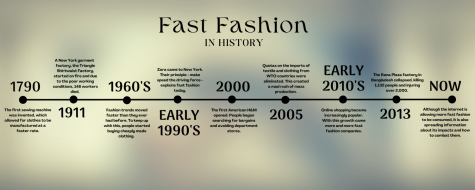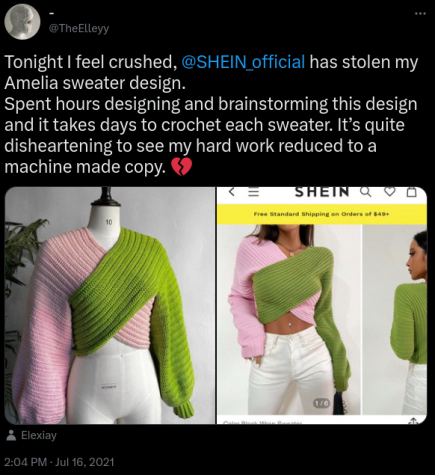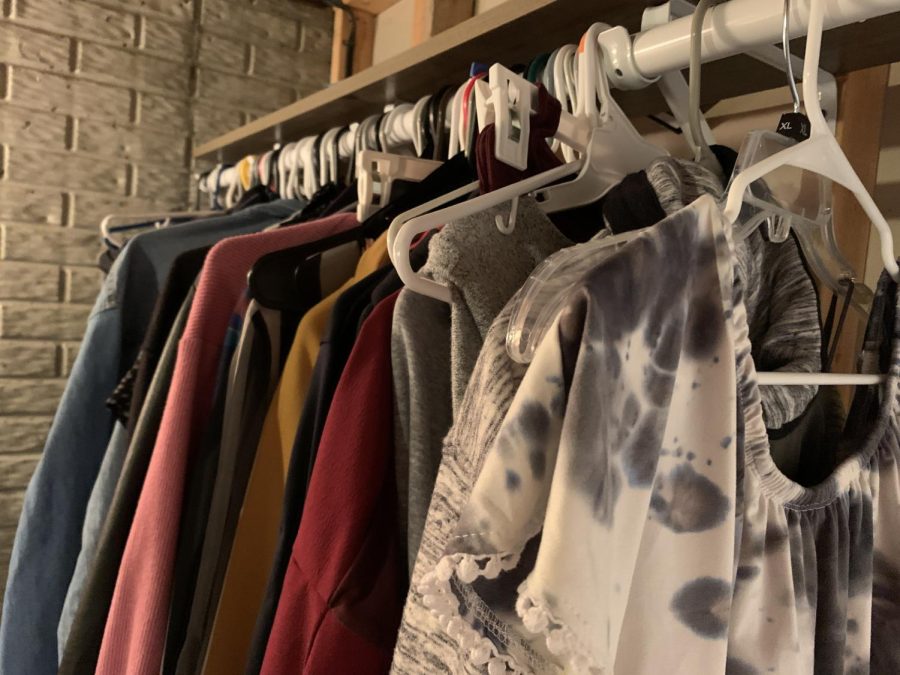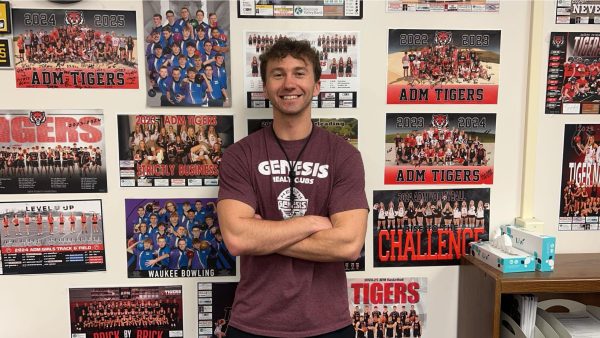The Danger Behind Fast Fashion
New clothes can raise a person’s self-esteem, allow them to expose their personality and boost their mood, but they can also pollute the earth, create unethical jobs and steal designs from struggling artists. So while your outfit may only total $10, the price of it is way higher.
Fast fashion is the concept of creating mass amounts of low-quality garments. Stores like Shein, H&M, Forever 21 or Romwe are some of the major culprits of fast fashion. In the last 10 years, the issues with the fashion world have begun to expose themselves. While it may appear that fast fashion is a recent issue, it has been going on for longer than people think.

When you choose your outfit, the impact of your jeans on the Earth probably isn’t on your mind, however, it might be in your best interest to give it some thought. According to earth.org, 10% of the world’s carbon emissions come from fashion production. The production of clothes uses extreme amounts of water and energy, just to go to the trash in a couple of weeks. 85% of textiles end up in the trash in a year and because of this, the microplastics (non-biodegradable plastics) from synthetic fibers fill the ocean and toxic dyes pollute the water and atmosphere. Fast fashion companies create mass amounts of cheap, non-recyclable clothing, which go on to destroy the oceans and atmosphere and grow landfills.
In the fast fashion world, clothes can be designed, manufactured and shipped out in just 2 weeks. With this speed comes great consequences. The speed of its creation means that the clothing quality from the past is extinct. Materials in textiles are cheaper and worse for the environment to make the cost go down. The lack of quality in the clothes means that companies can create lots of cheap clothing, increase the price and expect the customer to return quickly. Over time, the production of clothes has doubled as people’s attachment to consumerism grows.
Part of the reason these companies are able to sell their products for mere pennies is due to the blatant mistreatment of their employees. The clothes from well-known fast fashion brands are usually created in sweatshops that underpay, overwork and exploit their workers. A sweatshop is a small, manufacturing establishment where people are forced to work in unhygienic and immoral working conditions. Earth.org says that workers can be paid on the lower side of 33 cents an hour and are forced to work 14-16 hours a day, 7 days a week. Safety protocols are often not used, young children are employed and workers can even be beaten or verbally abused by sweatshop managers. Thousands of people have died or been seriously injured in garment factories over the last ten years and in 2013, 1,138 workers lost their lives to a collapsing roof in a Bangladesh garment factory.

Clothing brands like Shein and Romwe are well known for creating thousands of new designs a week, but these designs are usually not their own. It would be nearly impossible to create the number of original designs fast fashion companies advertise, so to improve their reputation, they often take designs from struggling artists and market them as their own. These clothes are mass-produced, lose their quality and no money is given to the original creator. According to NPR, while this is clearly unethical, it isn’t exactly illegal. In the fashion world, you cannot claim legal protection for basic clothing. For copyright protection, you must show the unique aspects of the clothing, which is difficult and time-consuming. Fast fashion companies usually know just enough about the grey area of copyright laws to get away with stealing original ideas.
Avoiding fast fashion is the easiest way to deal with the problems associated with it. While it may feel wasteful, even just one person refusing to pollute the environment, mistreat workers and steal art is enough to make a difference. To start living a sustainable life, people should always research their clothing before purchasing it. In general, companies like Shein, H&M, Urban Outfitters, Primark and Zara should be avoided in these cases. When it comes to sustainable companies, knowledge is your best friend. If a company is not very transparent about their materials or employees, it is probably best to avoid them in general. Researching your clothes is a great way to avoid fast fashion, but it isn’t the only option available to you.
Senior Norah Lipovac has been using her creativity since she was a kid to combat the dangers of fast fashion. Lipovac is an advocate for finding clothes from uncommon sources and frequents thrift shops and fabric stores. “Sewing is a hobby for me. I didn’t want to go out and spend a bunch of money on different things. When I was a kid, I made doll clothes because I couldn’t find the ones I wanted. Then I started making my own clothes and I even ended up making my own homecoming dress. ” She has created dresses, hats and altered a plethora of clothes to fit her better. “My clothes fit me better now. I don’t have to stick to standard sizes. I can make them fit how I want and get to make them my own instead of being told what to buy,” Lipovac shares. Norah also enjoys buying her clothes at thrift stores. She suggests checking items to make sure they are in good quality before purchasing them and going in with an idea of what you want. Lipovac enjoys visiting places like Goodwill when thrifting and trying to find local thrift stores when traveling. She believes that fast fashion is a greater problem than people know and they don’t understand the extent of it. “Obviously Shein is a popular fast fashion site that everyone’s hating on right now, but if you go to so many other sites, they use the exact same materials and create tons of new things every day.”
Fast fashion may not be something that is impacting you now. If you are low on money and need a new outfit, it can be easy to turn to a cheap clothing site if you have no knowledge of the production process. However, in the words of Lipovac, “How can they even produce that much in any ethical way? That just doesn’t exist.”







